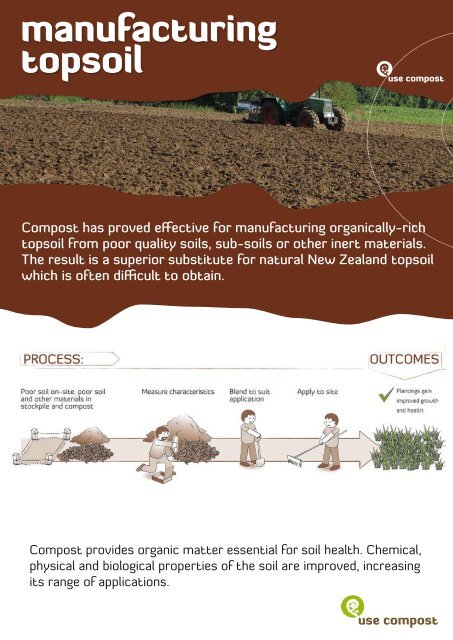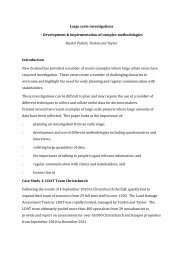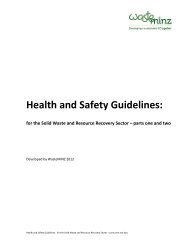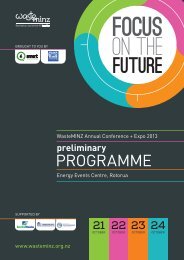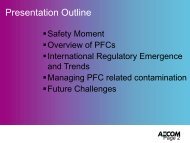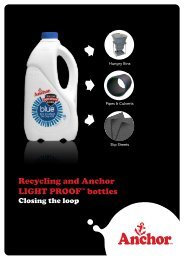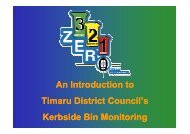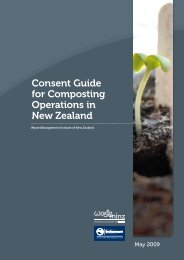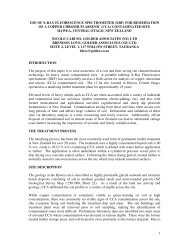manufacturing topsoil
manufacturing topsoil - WasteMINZ
manufacturing topsoil - WasteMINZ
- No tags were found...
Create successful ePaper yourself
Turn your PDF publications into a flip-book with our unique Google optimized e-Paper software.
<strong>manufacturing</strong><br />
<strong>topsoil</strong><br />
Compost has proved effective for <strong>manufacturing</strong> organically-rich<br />
<strong>topsoil</strong> from poor quality soils, sub-soils or other inert materials.<br />
The result is a superior substitute for natural New Zealand <strong>topsoil</strong><br />
which is often difficult to obtain.<br />
Compost provides organic matter essential for soil health. Chemical,<br />
physical and biological properties of the soil are improved, increasing<br />
its range of applications.
<strong>manufacturing</strong> <strong>topsoil</strong><br />
Methods<br />
Blend compost into existing<br />
soil (in-situ)<br />
Blend compost into<br />
stockpiled materials (ex-situ)<br />
Benefits of using compost<br />
▸ Improved soil structure & tilth<br />
▸ Improved water holding in light soils<br />
▸ Reduced bulk density in heavy soils<br />
▸ Macro and micro plant nutrients supplied<br />
▸ Increased soil cation exchange capacity<br />
▸ Reduced cost of <strong>topsoil</strong> necessary for the project<br />
▸ Improved soil microorganism activity<br />
▸ Protection against erosion<br />
▸ Improved visual appearance<br />
▸ Buffered soil pH<br />
Manufacturing to suit<br />
Topsoil manufactured with compost should be suited for<br />
a particular application (e.g., landscaping vs. sports turf<br />
establishment) and crop (e.g., vegetable garden vs. grass). Soil<br />
characteristics such as pH, electrical conductivity and texture<br />
should be taken into account. The existing site soil, and other<br />
materials used, should be tested to evaluate their characteristics.<br />
The final manufactured <strong>topsoil</strong> should be analysed to verify its<br />
characteristics.<br />
Blending<br />
The application rate of compost needed to improve the organic<br />
matter content of a soil can be determined. For instance, blending<br />
65 to 84m3 of moist compost having an organic matter content<br />
of 30% on a dry weight basis, with 100m3 of soil, would raise the<br />
organic matter of that soil from 2 to 5%.<br />
Transforming a droughty soil into a<br />
productive one using compost.<br />
1 2 3 4<br />
pH 4.4 5.9 6.9 8.3<br />
Organic matter % 1.1 5.1 9.2 23.4<br />
Soluble salts (mmhos/cm) 0.07 0.36 0.70 1.52<br />
Water-holding capacity % 25 39.5 54.9 80<br />
TKN (% dw basis) 0.04 0.05 0.10 8.59<br />
P 2<br />
O 5<br />
(ppm) 41 160 330 2500<br />
K 2<br />
O (ppm) 58 214 461 3200<br />
1 - Existing soil (sandy)<br />
2 - Soil : Compost 3:1<br />
3 - Soil : Compost 1:1<br />
4 - Compost<br />
Incorporating 20 to 30% compost (by volume) into soils of various<br />
texture and quality is often an appropriate application rate. The<br />
following generic directions are suggested if upfront soil analyses<br />
are not completed.<br />
Application recommendations<br />
In-situ<br />
▸<br />
▸<br />
▸<br />
▸<br />
Cultivate the soil, to a depth of 300mm when ground conditions<br />
are reasonably dry.<br />
Uniformly apply a 25 to 50mm layer of compost.<br />
Incorporate the compost to a depth of 100 to 200mm.<br />
Smooth the treated area, and remove any stones or debris from<br />
the surface prior to planting.<br />
Ex-situ<br />
▸<br />
▸<br />
▸<br />
▸<br />
▸<br />
▸<br />
▸<br />
▸<br />
Check that site drainage conditions have been rectified.<br />
Place soil, sand and/or aggregate piles near the compost pile.<br />
Determine compost inclusion rate and convert it into a blending<br />
ratio.<br />
With this ratio in mind, create a bed of compost (usually the<br />
lightest material), then apply the appropriate number of scoops<br />
of mineral materials evenly on top (heavier materials). Do the<br />
blending on concrete if possible.<br />
Using a front-end loader, scoop up the layered material from<br />
underneath, and dump it forward – to the front or past the soil<br />
bed. Try to ‘feather out’ the material from the front-end loader<br />
bucket when dumping so that it blends as it falls.<br />
Working through the middle of the soil bed, incorporate<br />
materials from either side. This should eventually displace the<br />
soil bed, moving it forward, as the blending continues.<br />
Continue until the materials are adequately mixed.<br />
The manufactured <strong>topsoil</strong> should be spread a minimum of<br />
150mm deep for turf and 300 to 600mm deep for tree/shrub<br />
planting areas.<br />
Compost can often supply the nutrients needed for the first 6<br />
to 12 months after planting. Turf and food gardens are likely to<br />
require additional fertilization.<br />
Developed by<br />
PO Box 31580 North Shore City 0741 Auckland . tel 09 4866722 . www.wasteminz.org.nz


